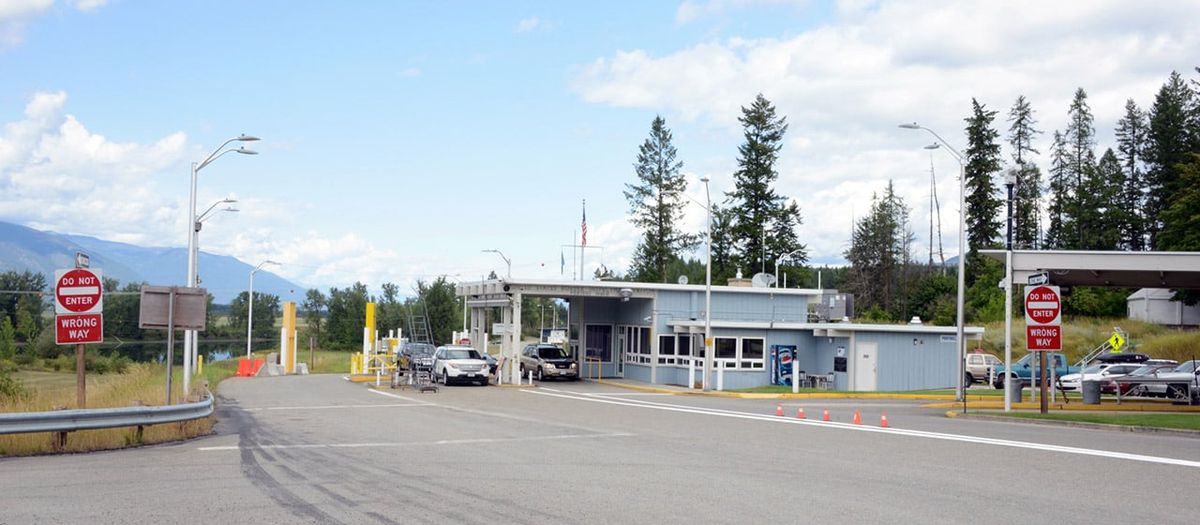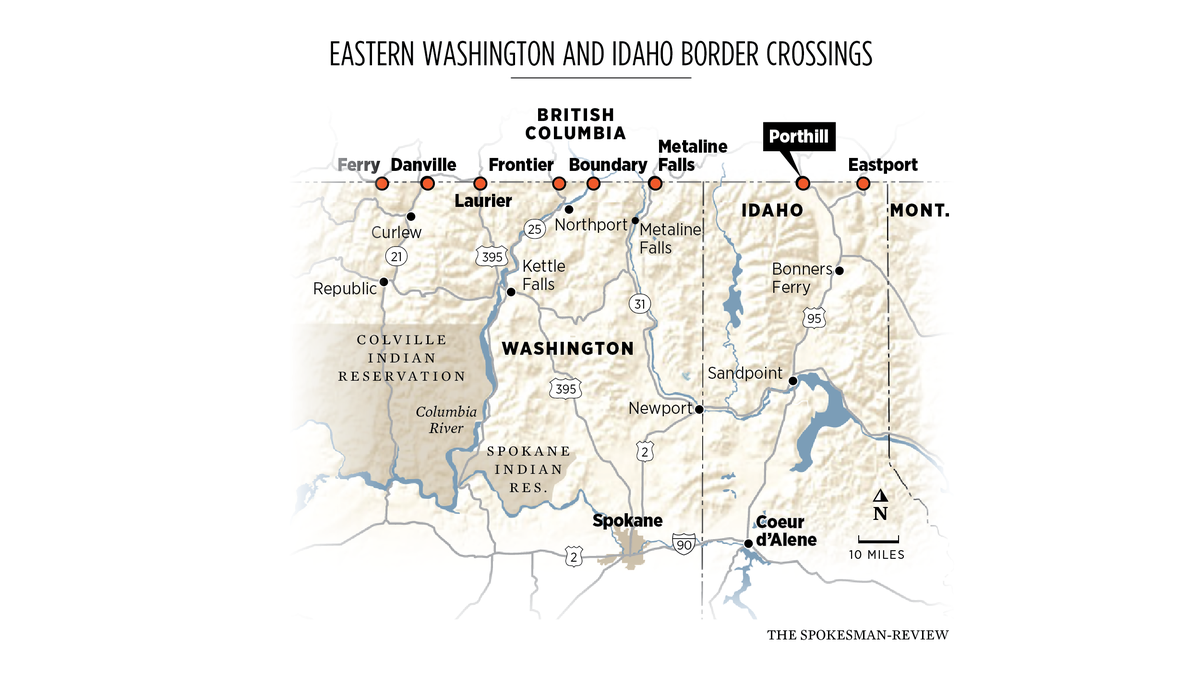Getting There: Expansion planned for U.S. border crossing at Porthill, Idaho
Porthill land port of entry between Idaho and British Columbia. (U.S. General Services Administration)
Plans to rebuild the U.S. port of entry at Porthill, Idaho, have prompted questions from residents at the tip of the Panhandle about why the border crossing hasn’t returned to prepandemic hours.
Almost three times larger than the existing building, the new facility is meant to improve traffic flow and better accommodate customs staff, according to the U.S. General Services Administration, which is overseeing the project.
But residents say there isn’t a traffic problem at the remote border crossing into Canada; the final environmental assessment released last week states that major congestion has not been an issue and traffic is not expected to increase.
Daily traffic is still below what it was before the pandemic.
Jason Givens, a U.S. Customs and Border Protection press officer, said in an email the building is outdated and has been on a replacement schedule. The building was not designed for the technology and staffing it now uses.
“The new facility is not being built to expand operations, but to provide a safe work environment that meets the technological needs of the work done by CBP today,” Givens wrote.
The project is part of a $3.4 billion package of land port upgrades funded by the Bipartisan Infrastructure Law.
Porthill’s modernization is estimated to cost $45 million to $55 million. Up to $15 million will come from the Inflation Reduction Act to make the facility fully electric and sustainable.
The environmental assessment received a finding of no significant impact and construction is expected to begin January 2026.
The two-story, 9,400-square-foot building will include a public waiting area, enforcement areas, commercial inspection support spaces, offices, a break room, fitness room, mechanical space, a technology room and two public restrooms. Configuration will be determined in the design phase.
The new facility will be built adjacent to the current one-story 3,500-square-foot facility that was built in 1967. A border crossing has occupied the site 27 miles northwest of Bonners Ferry since 1894.
Porthill is one of two land crossings in Idaho. The other, Eastport, is about 15 miles east as the crow flies and is open 24 hours a day.
The Porthill crossing will stay open throughout construction with no significant traffic impacts, according to GSA. When the new facility opens, the old building will be demolished.
The project also will reconfigure and expand the vehicle lanes to improve efficiency, the environmental assessment said.
While overall traffic congestion is not a typical concern at the port, GSA Public Affairs Officer Christi Chidester Votisek said processing times and traffic flow for individual vehicles, especially commercial vehicles, is inefficient. The proposed project seeks to alleviate these issues and improve customer service to travelers.
The port processes a limited number of permitted commercial vehicles,
Only one private vehicle lane has an inspection booth, attached to the main building. A secondary private vehicle lane is used during peak times. A separate commercial inspection lane requires the operator to park, then enter the facility.
The new facility will have four lanes, and each lane will accommodate private and commercial vehicles with an inspection booth.
During the pandemic, the border closed except for essential services.
Traffic over the border has been slow to return even a year after the last restrictions were lifted. For example, 9,700 private vehicles crossed through Porthill in April 2019, according to the Bureau of Transportation Statistics. That dropped to 159 at the height of the COVID-19 shutdown a year later. April 2024, the most recent month with published data, had 7,300 crossings.
The pandemic devastated border businesses and they are still struggling.
Next door to Porthill is Jake’s Landing, a family-owned-and-operated complex with a gas station, convenience store, restaurant, parcel depot and event space. Most customers come from Canada for recreation or cheaper prices.
Lars Jacobson bought the business just nine months before the pandemic. Then business plunged to one or two customers a day. It took half a million dollars in loans and donations not to go out of business, and he estimates it will take near a decade to recover.
They are doing better now, but still only 50% of what it was before the pandemic. Customers got out of the habit of coming, Jacobson said.
Advertising in Canada has helped some.
But recent talks of a potential strike by Canadian border workers have spooked Canadians not wanting to get stuck or delayed on this side of the border, Jacobson said. He has noticed a significant drop in business since last month.
That makes him worry about the two-year construction project. Even though GSA says the construction will not affect traffic, Jacobson still thinks it will be enough of an inconvenience to deter a critical percentage of his customers. He doesn’t think his business will survive if the project goes forward.
“It is going to destroy us,” Jacobson said.
Extending the port’s hours of operation back to what they were before the pandemic would make a big difference, Jacobson said.
Before the pandemic, and for as long as some locals can remember, the hours were 7 a.m. to 11 p.m.
Rykerts, the port on the Canadian side, has returned to these hours. (Rykerts has a slight seasonal difference since the area around the nearby town Creston, British Columbia, doesn’t observe daylight saving time. Hours are 8 a.m. to midnight in the winter.)
When the border reopened, Porthill had reduced hours, closing at 5 p.m.
U.S. Customs and Border Protection announced in July 2023 the new permanent hours would be 7 a.m. to 7 p.m., citing a traffic analysis conducted after temporarily extending the hours earlier that year.
The analysis included an hourly breakdown, overall volume and types of conveyances that crossed the border, according to a CBP news release. The agency also identified alternate ports of entry, reviewed community impact and evaluated staffing and operations costs.
For several years, CBP has documented a reduction in private vehicle and pedestrian traffic at some ports along the northern border, the news release added. Some of these ports permanently reduced hours prior to 2019.
CBP has no plans to further expand the hours, Givens said.
The mismatch with the Canadian hours confuses and inconveniences travelers. Some signs still list incorrect hours.
In April the three members of North Idaho’s congressional delegation – Sen. Jim Risch, Sen. Mike Crapo and Rep. Russ Fulcher – wrote an open letter to the Department of Homeland Security, requesting the hours return to 11 p.m. to improve commerce.
“Porthill plays a critical role in facilitating the flow of workers, tourists, and families across our border,” the delegation wrote. “It is also a key crossing for members of the Kootenai Tribe of Idaho, whose ancestral homeland is bisected by the international border.”
The letter noted that comments from residents at public hearings for the project expressed confusion about the reasoning for the expansion to accommodate traffic while the hours haven’t been returned because of decreased traffic.
“We echo these residents’ confusion,” the letter said.
Replying to the lawmakers, CBP Commissioner Troy A. Miller wrote that the agency continuously evaluates traffic levels and operational efficiency across all ports to best allocate limited resources. Porthill’s management has been in contact with Idaho Transportation Department to update old signs to reflect current hours, Miller added.
In a written comment on the project submitted in January, Boundary County resident Doug Kim-Brown called it “nonsense” to invest millions of dollars into a crossing the border agency says is underused.
“If you are going to spend that kind of money, bring back the hours of access,” Kim-Brown wrote. “The current arrangement discourages commerce, frustrates tourists and local people alike, and discourages cross border ties.”
In written responses to Kim-Brown and similar public comments about lack of traffic and congestion, GSA emphasized the other objective is to meet CBP’s operational needs.
GSA plans to obtain a 1.2-acre easement from Idaho Transportation Department west of the port to accommodate the expansion.
In earlier plans, GSA had considered acquiring an additional 1.5 acres of private property – part of Jacobson’s property at Jake’s Landing. The finding of no significant impact said GSA has since re-evaluated the acreage required and no longer intends to acquire it.
Luke Reimer, a spokesperson for Canada Border Services Agency, said there are no immediate plans to redevelop the Rykerts port of entry in British Columbia.

